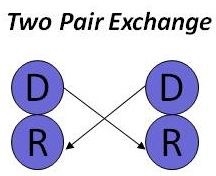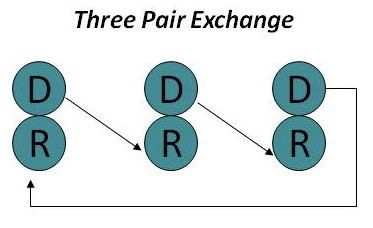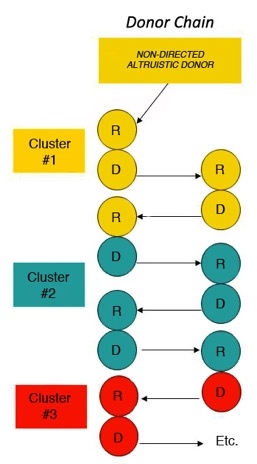Initially, donor exchange programs started small, matching two or three incompatible pairs within a single transplant center. Now, it has grown to a system that can involve several recipient/donor pairs from different institutions around the country.
At Weill Cornell Medicine and NewYork-Presbyterian, several types of paired donation are available.
In many cases, recipient/donor pairs turn to KPD because the donor and intended recipient are incompatible. Some pairs do not have compatible blood types, so organ donation is only possible if the recipient undergoes special treatments to try to overcome the incompatibility. Other pairs fail crossmatch testing, which checks if the recipient’s cells will attack the donor’s cells.
Compatible recipient/donor pairs also participate in KPD to find better-matched kidneys and to increase the chances that the transplanted organ will function better and last longer.
Visit our KPD Glossary to learn more about the factors that determine donor/recipient compatibility.
Kidney Paired Donation has progressed over the past decade from simple donor and recipient swaps at a single transplant center to complex cross-country kidney paired donations that utilize commercial airline travel to ship donated kidneys from one transplant center to another.

Two Pair Exchanges usually occur at a single transplant center, where two incompatible pairs "swap" donors to enable two compatible transplants.

Three Pair Exchanges also usually occur at a single transplant center, however, three incompatible pairs "swap" donors to enable three compatible transplants.

Kidney Paired Donation/Exchange Transplants are more complicated, because they often involve multiple incompatible donor and recipient pairs, multiple transplant centers, and utilize an altruistic donor.
Sophisticated software generates these donor chains by searching a database of incompatible donor and recipient pairs in order to match up donors and recipients that are compatible.
An altruistic (non-directed) donor starts the chain of transplants by providing an "extra" kidney (because the altruistic donor has no intended recipient). This kidney is given to a recipient whose donor is incompatible, and that person's donor then donates to someone in the registry with whom they are compatible, and then that person's donor gives to another recipient, and so on.
The different "clusters" of transplants shown at the right reflect the different groupings of transplants that may occur at different times.
For example, the donor of the last recipient in cluster # 1 (the green D attached to the yellow R) kicks off the next cluster of transplants at a later date, after their incompatible intended recipient had already been transplanted. These types of donors that wait and kick off another cluster of transplants are called "bridge donors".
Alternatively, if these donors cannot wait to donate, their kidney could be donated to someone on the deceased donor waiting list.